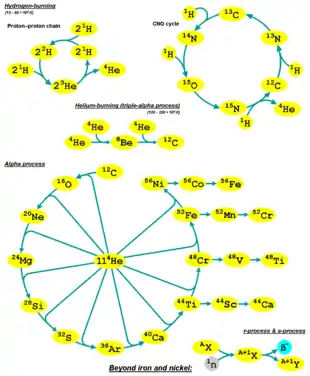Alpha process
The alpha process, also known as the alpha ladder, is one of two classes of nuclear fusion reactions by which stars convert helium into heavier elements, the other being the triple-alpha process.[1] The triple-alpha process consumes only helium, and produces carbon. After enough carbon has accumulated, the reactions below take place, all consuming only helium and the product of the previous reaction.

E is the energy produced by the reaction, released primarily as gamma rays (γ).
It is a common misconception that the above sequence ends at (or , which is a decay product of [2]) because it is the most stable nuclide - i.e., it has the highest nuclear binding energy per nucleon, and production of heavier nuclei requires energy (is endothermic) instead of releasing it (exothermic). (Nickel-62) is actually the most stable nuclide.[3] However, the sequence ends at because conditions in the stellar interior cause the competition between photodisintegration and the alpha process to favor photodisintegration around iron,[2][4] leading to more being produced than .
All these reactions have a very low rate at the temperatures and densities in stars and therefore do not contribute significantly to a star's energy production; with elements heavier than neon (atomic number > 10), they occur even less easily due to the increasing Coulomb barrier.
Alpha process elements (or alpha elements) are so-called since their most abundant isotopes are integer multiples of four, the mass of the helium nucleus (the alpha particle); these isotopes are known as alpha nuclides. Stable alpha elements are: C, O, Ne, Mg, Si, and S; Ar and Ca are observationally stable. They are synthesized by alpha capture prior to the silicon fusing process, a precursor to Type II supernovae. Silicon and calcium are purely alpha process elements. Magnesium can be burned by proton capture reactions. As for oxygen, some authors consider it an alpha element, while others do not. Oxygen is surely an alpha element in low-metallicity population II stars. It is produced in Type II supernovas and its enhancement is well correlated with an enhancement of other alpha process elements. Sometimes carbon and nitrogen are considered alpha process elements, since they are synthesized in nuclear alpha-capture reactions.
The abundance of alpha elements in stars is usually expressed in a logarithmic manner:
- ,
Here and are the number of alpha elements and iron nuclei per unit volume. Theoretical galactic evolution models predict that early in the universe there were more alpha elements relative to iron. Type II supernovae mainly synthesize oxygen and the alpha-elements (Ne, Mg, Si, S, Ar, Ca and Ti) while Type Ia supernovae mainly produce elements of the iron peak (Ti, V, Cr, Mn, Fe, Co and Ni) but also alpha-elements.
References
- Narlikar, Jayant V (1995). From Black Clouds to Black Holes. World Scientific. p. 94. ISBN 978-9810220334.
- Fewell, M. P. (1995-07-01). "The atomic nuclide with the highest mean binding energy". American Journal of Physics. 63 (7): 653–658. Bibcode:1995AmJPh..63..653F. doi:10.1119/1.17828. ISSN 0002-9505.
- "The Most Tightly Bound Nuclei". hyperphysics.phy-astr.gsu.edu. Retrieved 2019-02-21.
- Burbidge, E. Margaret; Burbidge, G. R.; Fowler, William A.; Hoyle, F. (1957-10-01). "Synthesis of the Elements in Stars". Reviews of Modern Physics. 29 (4): 547–650. Bibcode:1957RvMP...29..547B. doi:10.1103/RevModPhys.29.547.
